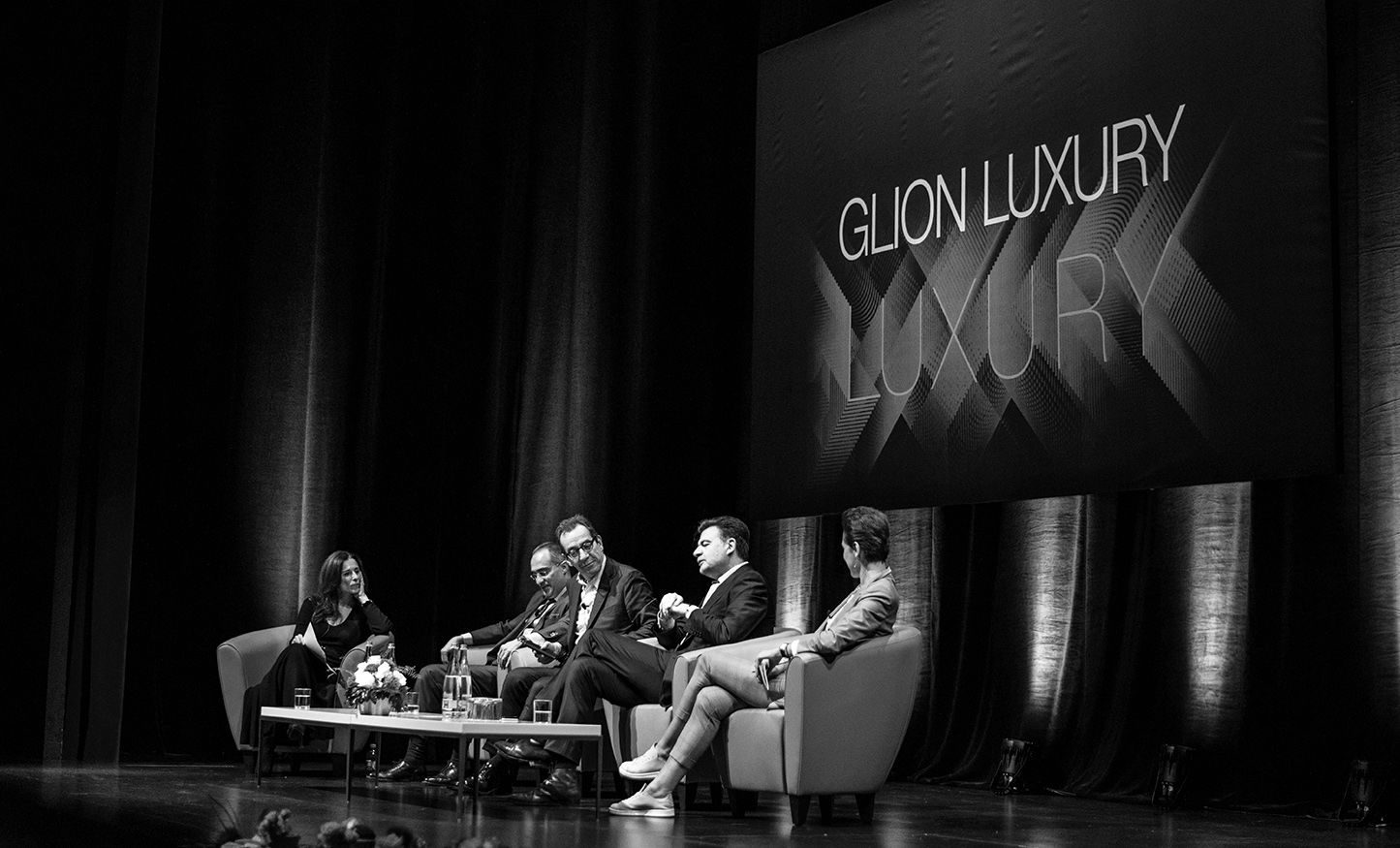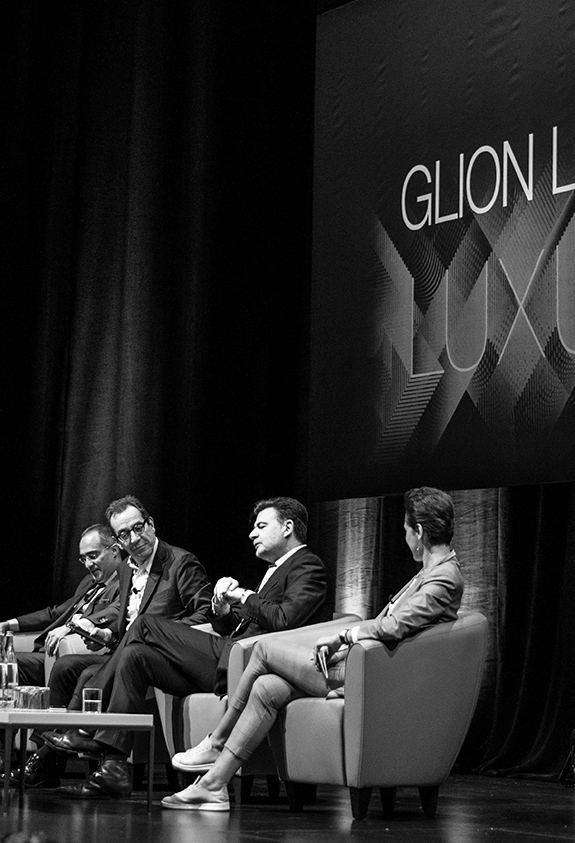


Around 700 Glion students and luxury industry representatives attended Glion’s Experiential Luxury Conference to gain insights from luxury industry leaders. Held on 10 October 2017 at the CO2 in Bulle, Switzerland, Glion’s third annual Luxury Conference featured guest speakers from renowned brands in hospitality, luxury goods, gastronomy, art, wellness and more. Through presentations and roundtable discussions, these panelists shared their views on authenticity, passion, storytelling and traceability — and what it means to deliver luxury experiences today.
Ethical Luxury, Traceability and Authenticity
“We live thanks to the hands of people whose stories are not told,” said Ms. Caterina Occhio, Founder and CEO of SeeMe, a fair trade jewelry brand. Among what is currently a niche market of ethically aware consumers, Ms. Occhio sees great potential for growth. “The product we buy should tell the story of the people and the places they are made from,” she said. “Luxury is about craftsmanship: back to the hands, back to the people.”
Corporate social responsibility is increasingly relevant to global brands, and the luxury industry is no exception. Mr. Luca Solca, Managing Director and Sector Head for Global Luxury Goods at Exane BNP Paribas, observed: “In this era, when everyone can find lots of information about brands online, luxury goods brands need to think about how they can stand a transparency test.” The importance of transparency was underlined by Mr. Roberto Eggs, Chief Operating Officer of Moncler, who described how Moncler implemented full traceability on the down within its products after facing criticism in 2014. The move to embrace ethical rules “changed the culture of the company, making us more responsible,” Mr. Eggs said.
Building Connections through Client Feedback
From online reviews to the sharing of experiences on social media, the digital era has transformed how clients can talk with and about luxury brands. Mr. Eggs noted that when Moncler invited clients to give feedback through digital channels such as SMS, WhatsApp, WeChat and email, “more than 35% of clients left comments. That shows they’re connected with the brand — they want to give feedback.”
Mr. Rami Z. Sayess, Regional Vice President of Four Seasons Hotels and Resorts, is convinced of the value of listening to customers. He said, “Today we’re connected to the customer at a faster pace than before. How you react is the key to your success. Every company will have glitches and shortcomings; it’s the art of how you will respond to this feedback [that counts].” For today’s luxury clients, the sharing of experiences is particularly important. Mr. Sayess added, “Make sure that people leave with a story to tell. That’s the connection with the brand.”
Storytelling and Creating Memorable Experiences
Making products available online gives luxury clients the option to browse not only a particular store, but an entire brand’s collection. “Digitalization offers the possibility to turn every store into a flagship store,” said Mr. Eggs. He explained that Moncler takes advantage of its window displays and retail shops to showcase new products and illustrate the brand: “Luxury’s still about storytelling and making people dream.” Mr. Solca also pointed out the need for luxury brands to use physical space wisely. “What is it in your store which actually speaks about the DNA of your brand?” he asked.
From architecture and design to service, the creation of a particular atmosphere and space is key to providing clients with a unique experience. This is especially true in luxury hospitality. Describing how Four Seasons adapts its hotels to reflect local destinations, Mr. Sayess said, “It’s important to give the customer a sense of place. You don’t need to be everywhere. What’s important is that when you leave a destination, you talk about that sensation you felt, whether it was in a hotel or in a store.”
Seducing a Wider Client Spectrum: Going Above and Beyond
As the profile and demands of luxury clients evolve, successful brands are going the extra mile to meet and exceed expectations. Mr. Paul Clark, Group Director of Human Resources of Mandarin Oriental Hotel Group, remarked, “Today delivering the expected is not enough. You have to deliver the unexpected. Take an airline journey, for example: there are certain things that should be happening. But the difference is when you go beyond, delighting the customer.”
In the wellness industry, helping clients to achieve both short-term and long-term results is key to ensuring loyalty. “There has been a shift in the market from preserving my wealth to preserving my health,” said Mr. Simone Gibertoni, CEO of Clinique La Prairie. For him, a fundamental question is: “How can we follow clients when they have left?” To build lasting relationships with clients, Clinique La Prairie has implemented innovative strategies, such as enabling clients to stay in touch with their longevity doctor from anywhere in the world.
On Caviar and Pizza: Enticing a New Generation
To stay relevant with younger clients, it is crucial that luxury brands understand the contexts and values of these new generations. Mr. Peter G. Rebeiz, Chairman and CEO of Caviar House & Prunier, shared an entertaining and illuminating anecdote involving his teenage son, who developed a passion for caviar after inviting friends over to make flatbread “pizzas” with the luxury food. According to Mr. Rebeiz, this unconventional approach would have had his father rolling in his grave, but Mr. Rebeiz remains convinced that “the biggest danger we face is not speaking the language of the generation of today and tomorrow.” He stressed, “We need to address the informality of consumption today.” In Mr. Rebeiz’s view, his challenge is to take caviar “from the dining room into the kitchen” — to make a luxury food product with a long history and heritage relevant for a new generation.
Dr. Bertold Mueller, Managing Director of Christie’s, addressed the challenges of connecting with a diverse range of clients. In the past, clients of Christie’s were largely based in North America and Europe, but today they are increasingly global. “We need showrooms, but we also need to be present in the digital world,” Dr. Mueller said. “One-third of our new clients come to us through online auctions.” Christie’s has also developed exclusive courses and programs to immerse young clients in the art industry.
In the hospitality world, Mr. Clark discussed how Mandarin Oriental has reacted to the shift among young clients from the material to the experiential. While luxurious rooms like the “Presidential Suite” may once have been the most coveted, today’s clients seek something else: “In Hong Kong, our ‘Entertainment Suite’ has a massive TV, a DJ booth, an open kitchen — it’s an ideal place to invite guests.” From an authentic Peruvian restaurant in Miami to a New York City bar on the 35th floor, Mandarin Oriental has also made a point of offering distinctive food and beverage outlets — each with their own personality.
Using Emotions to Create Journeys of Discovery
In the day’s final keynote speech, Mr. David Sinapian, CEO of Groupe Pic and President of Grandes Tables du Monde, shared his views on redefining luxury in the context of hospitality. Mr. Sinapian believes that “emotions are the new El Dorado.” He observed, “Going to a fine dining restaurant is like a journey. It’s like going to the theater.” Through a blend of human skills, ambiance, design and spirit, and tableware, Mr. Sinapian’s goal is to “make our guests have an unforgettable experience based on emotions, which make them feel unique.” Particularly in fine dining, luxury brands have the opportunity to propose new experiences and engage clients through the five senses — and through emotions.
Addressing a wide range of topics, Glion’s Experiential Luxury Conference provided students and industry representatives with inspiration and timely insights.
Interested in studying luxury at Glion? Learn more about Glion’s Luxury Brand Management specialization here.

















